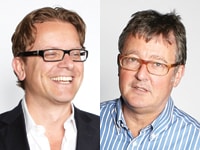
Pharmaceutical research and development (R&D) teams are facing urgent challenges. Their big brands are tumbling over the ‘patent cliff,’ and the increasing burden of costs on governments and individuals to pay for the healthcare of an ageing generation is hobbling the launch of new drugs.
Too often the chosen remedy is a contradictory mix of cost cutting and exhortations to up the output of successful new drugs. This may be painful to hear, but most R&D teams we’ve worked with are comprised of people who are risk averse and analytical, not entrepreneurs. It’s unsurprising to find low morale lurking in these organisations.
The crisis has promoted radical new ways of developing drugs. But radical solutions take time to take hold. The good news is that many complex, regulated businesses outside of healthcare have increased the efficiency of their innovation engines, and many have implemented hundreds of subtle, inexpensive changes that aggregate to a wholesale change in culture. If pharma R&D teams take a look at their practices and experiment with how they work, they, too, can become more agile and productive, even with fewer people and resources.
The single most important driver of innovation is passion. Sadly, many of us don’t get enough of that at work. Here are three strategies for developing passion in pharma R&D teams.
Whites of their eyes
In the 90s, many packaged goods companies got the insight bug. What had been called market research, a paper-heavy desk exercise, was replaced with hands-on executives who swapped PowerPoint for notepads, got out of the office, and saw how and why their consumers did what they did. They were shopping, eating, and even clubbing with their customers. This adventurous approach to seeing the whites of customers’ eyes was not restricted to marketing. Scientists and technicians left the lab for the living room, too. We have found this approach to be highly effective.
Here’s an example. A global pharma client received bad news. Its antidepressant drug failed its phase II trials, a development with potentially fatal implications for share price. But what did ‘fail’ mean? Digging into the target product profile (TPP) revealed ambitious performance goals across key dimensions of efficacy, side effects and tolerability. To be successful, this had to be a wonder drug. The scientists had been stuck in the lab too long. They were struggling to connect with the emotions that patients and their caregivers were experiencing.
We travelled across the US to meet people suffering a wide range of depression. We met a musician whose guitars were covered with dust, a man who hadn’t been outdoors for years, and a painter who was hearing voices as we spoke to her. We met people who were young, old, who had care, and who had no one to turn to. This experience was moving, even for scientists who had studied depression for years.
What the scientists took away from their trip was how crippling the side effects of antidepressants could be. They had read about this, but not witnessed it. One teenage sufferer had told them that full remission wasn’t worth it if she gained weight, stopped sleeping, and sweated all day. The TPP demanded efficacy above all else. Patients wanted a more balanced approach.
The scientists went back to the lab and amended the TPP. They rebalanced what they were looking for: a drug with a slightly lower performance measure and less intrusive side effects. And guess what? They already had the molecules to deliver against that TPP. The road trip paid off. The scientists didn’t have to start from scratch, slashing development time by several years – a turn of events predicted to save the company more than $1bn.
Stop being sensible and serious
Most people in business apply an abundance of analysis, objectivity, and scepticism to new ideas. We call these ‘reductive’ behaviours. Because their cultures are based on the scientific discipline of clinical trials, pharma companies are thronged with reductive thinkers. Innovation reductive thinking is vital when applying commercial judgments to emerging solutions. But without ‘expansive’ thinking, those new solutions will be strangled at birth.
Expansive thinking is what a child does when you give him or her a gift in a box, and he or she spend the next week ignoring the gift and turning the box into a car or a house. It’s thinking that seeks multiple possibilities rather than one right answer. It’s based on playfulness and positivity: an agreement to build on each others’ ideas rather than knock them down. Since we were all children once, we can rediscover how to think expansively with a bit of practice.
There are simple, low cost and even fun tools that can inject passion and impact into innovation
The trick to expansive and reductive thinking (and, therein, the secret to effective collaboration) is to make sure that, when solving a problem, your team knows it’s either thinking expansively and generating solutions or that it’s time to think reductively and move into choosing mode. You’re avoiding situations where these behaviours get mixed up. We’ve all been in meetings where somebody has suggested an idea, and five helpful souls have told him what’s wrong with it in the same moment. And we’ve all been in meetings where you’re trying to make a choice, but others want to open up the discussion to new ideas.
We use a term called ‘signalling’ in our innovation training. It means acquiring the habit of letting those around you know if you need expansive or reductive thinking at that point. Consider a typical exchange:
Scientist A: “Hey, why don’t we create a website and release our challenges and data for the world to work on — an open innovation programme.”
Scientist B (raises eyes to heaven): “Hmm, we tried that, and it didn’t work.”
This isn’t a healthy dialogue. Now let’s ‘signal’:
Scientist A: “Hey, I’ve got an idea, but it’s only half-formed. Can you help me build it? Why don’t we create a web site and release our challenges and data for the world to work on – an open innovation programme.”
Scientist B (realising an expansive response has been requested): “OK, let’s explore. We could do that, but we’ve not had a lot of luck. Your idea makes me think we should hold a conference and invite a small number of leading researchers to collaborate. Now there’s an idea I hadn’t thought of!”
Introducing planned expansive and reductive thinking to pharma R&D teams, managed with clear signalling, transforms a team’s ability to collaborate and innovate.
Science fiction, not science fact
One of the biggest challenges facing pharma R&D leaders is knowing where to place strategic bets that won’t pay off for 10 to 20 years. Smart organisations are learning that approaches they used to rely on for future-scenario development don’t work anymore. They have to think like science fiction writers, not rational analysts, and develop scenarios to place bets that are leaps ahead of what the competition is seeing.
To ensure the bets they place are smart, we developed an approach called ‘foresight’. It marries future ‘certainties,’ such as demographic change, with collaborative ‘imagining’ events to produce scenarios with a 10-20-year horizon.
Recently we used this approach for a major fuels and lubricants manufacturer. We sought to broaden the question beyond current paradigms, engaging experts and academics outside the category. In this case, the usual question might have been, “what’s the future of lubricating oils?” But asking that question ensures that answers remain inside the current business model. So we asked, “what’s the future of mobility?” We gathered anyone who had anything to say on the future of mobility. Our R&D scientists heard from travel writers, airline stewards, chauffeurs, people with restricted mobility, road planners, and even someone who claimed to have invented a teleportation device. Immersing themselves in a ‘future world’ of possibilities in which their product or brand may play a role stretched the team’s thinking. The company is now allocating multi-million dollar investments in future ‘mobility worlds’ that were not obvious at the outset.
We’ve mirrored this approach with other pharma R&D teams. In a recent exercise looking at compliance in respiratory medication, we flipped the challenge from ‘how to comply’ to ‘how to create desire.’ We introduced scientists to fashion and perfume houses, and they realised that the formulation development of, say, inhalers was less important than the aesthetics. This prompted a shift in investment away from formulation research and toward the development of cool-looking devices, which had shorter lead times and fewer regulatory hurdles.
Seeing the whites of patients’ eyes, signalling intent, and swapping ‘sci-fact’ for sci-fi are simple, low cost, and even fun tools for injecting passion and impact into innovation.





